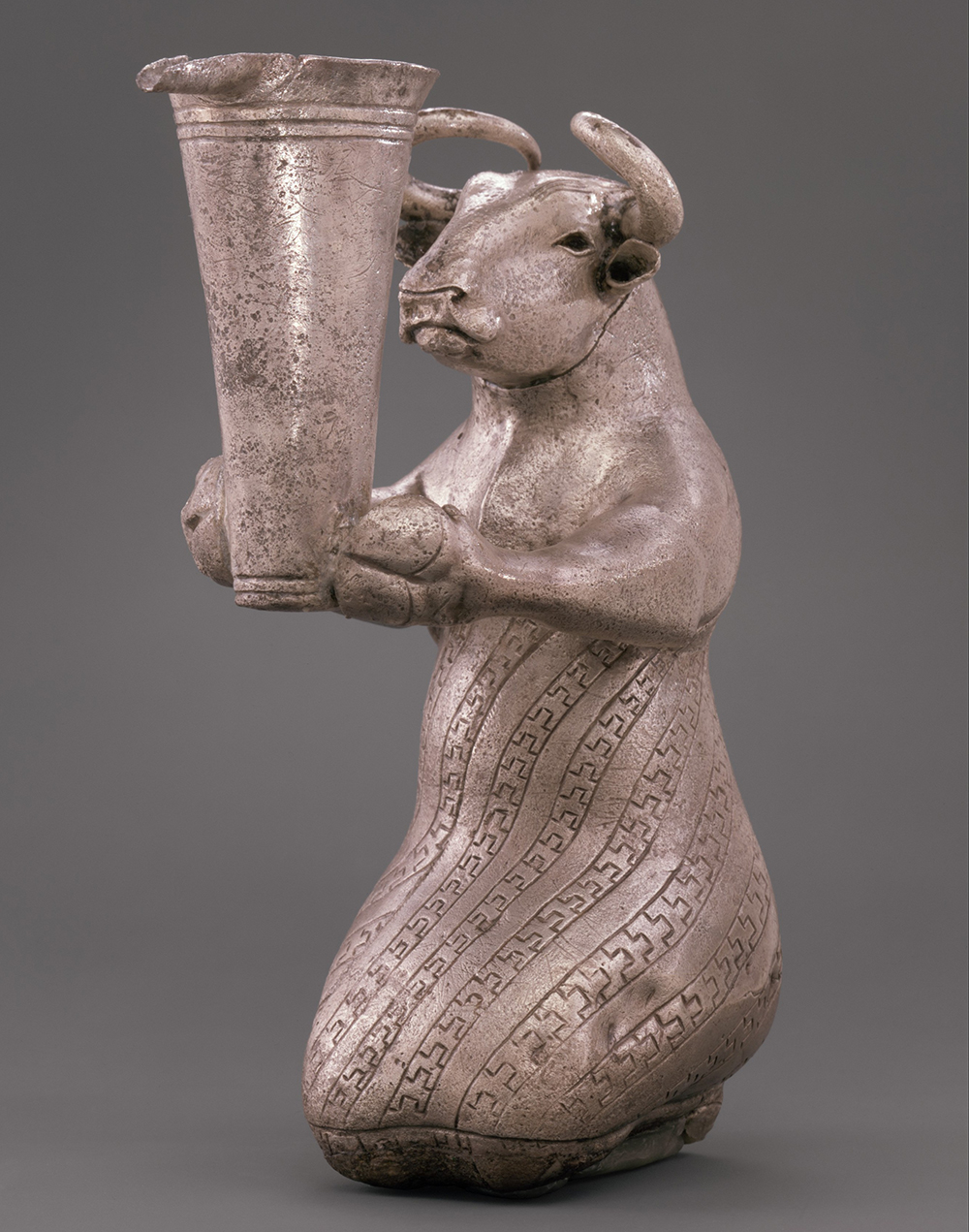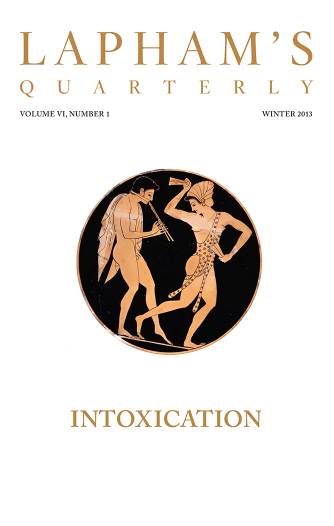There is no greater sorrow than to recall a happy time in the midst of wretchedness.
—Dante Alighieri, 1321
Books and Scholars’ Possessions (detail), by an unidentified artist, early twentieth century. The Metropolitan Museum of Art, Purchase, Shelby White Gift, 2005.
Audio brought to you by Curio, a Lapham’s Quarterly partner
In our decrepitude, we remember but one word in ten thousand.
So runs an entry in a commonplace book that I began keeping in the early 1990s, as a nondecrepit twentysomething. The mere act of transcription has brought this sentence to mind countless times in the past twenty-five years. It’s a line about forgetting that itself refuses to be forgotten, as though its syllables contain the antidote to oblivion.
The words are two centuries old. The writer’s real name is lost; she’s been dubbed Lady Hong, Lady Hyegyong, Princess Hong. In her sixties she wrote a series of memoirs about the fate of her late husband, the mentally ill Prince Sado. His life had come to an end three decades earlier, in 1762, when after years of erratic, violent behavior, he was commanded by his father, the Korean king Yongjo, to climb into a rice chest. Eight days later, he died.
Her papers, never meant for publication, circulated among family after her death: “I have recorded what I experienced and how I felt in the past, to let others know. My memory has declined, however, and I could not recall many things. Thus I have recorded only what I was able to remember.” Edited into a book by unknown hands and first published in 1939, it became known as the Hanjungnok, translated variously as Memoirs of a Korean Queen, Reminiscences in Retirement, The Memoirs of Lady Hyegyong, and A Record of Sorrowful Days.
I start my commonplace book while in Korea, sometime in the winter of 1992–93, where I have a postcollege internship at an international law firm. It doesn’t start as a book, just as a file I keep on my work computer. I’m at work six days a week, proofreading correspondence and contracts written in English in a large office building downtown that seems to have secrets on every floor: a bank, places to eat, a small shop that sells cunning nail clippers—the first I’ve seen that direct the clipping inside, rather than let it fly into the air.
The first passages in my commonplace doc are plucked from the few books I’ve brought from home or ones borrowed from the United States Information Service, an institution whose purpose I cannot decipher. Exile limits choices, makes for chance affinities that become stronger than they might otherwise be at home. The Executioner’s Song becomes all-consuming, fodder for the doc, though I never touch another Norman Mailer novel once I return. Vladimir Nabokov is represented by extracts from his letters to Edmund Wilson; Ernest Hemingway, by a piece in the collectanea By-Line: “The only people for a serious writer to compete with are the dead that he knows are good.”
In my commonplace doc, such attractively grandiose statements rub up against humbler fare. One mind-numbing afternoon on the seventeenth floor, a standard sentence in legalese strikes me as perfectly pointless, so I add it to the document as well:
WHEREAS, Licensee is desirous of obtaining a right and license to manufacture and sell juices and juice drinks using Licensor’s technical information and under Licensor’s registered trademarks, which Licensor is willing to grant upon the terms and conditions hereinafter provided.
Before leaving the job, I print everything out, four single-spaced pages, then delete the file from the computer. (This is before the internet; I don’t even have email.) Back in the States, I trim the pages and tape them into a blank journal: the start of my commonplace book as physical object. I don’t return to Korea for another twenty years. Today the ink is still dark, almost wet looking, as though the printer has just spit it out.
I keep up the habit for a while, writing new entries. These early pages are crammed for some reason, as though I feared running out of room; the handwriting veers from a dark, uniformly flowing line without a single error, to weak-Bic’ed additions plagued by scratch-outs. There are quotes from musicians, paragraphs clipped from the New York Times, passages from Sontag and Philip K. Dick, Wodehouse and Kim Jong Il. One entry I can recite verbatim is a line of anonymous marginalia found in a library book titled Memory: “To forget, we must not KNOW we are doing so, or else we are NOT forgetting.”
This steady stream of wisdom continues for a time, and today I can pinpoint my discovery of Haruki Murakami, the start of my obsession with The Anatomy of Melancholy. Quotes don’t generally play off each other, with some exceptions.
“Give me silence, water, hope.”—Pablo Neruda
is followed by
“Oh, Time, Strength, Cash, and Patience!”—Melville, Moby Dick
A flurry of entries appears circa 2011, as I settle into becoming a father of two. Then there’s nothing until last year, a seven-year gap indicative of life gaining the upper hand over literature.
Nowadays, if I come across a choice passage in a book or newspaper, I’ll snap a photo with my phone. I might copy and paste a neat turn of phrase found online into an email that I send to myself. All of these get lost in the digital shuffle, slip from the mind. It’s too easy to frame, click, and forget. I commit page after page to the cloud.
A week after I write this, I realize it isn’t entirely true—rather, that there was an intermediate period between commonplace bookkeeping and phone-enabled archiving, overlapping with the former and superseding it in terms of quantity. I speak of a blog. It is significant that I should forget a project with such ostensibly similar goals. I maintained it from the end of 2004 to the start of 2014, though the posts sputter out about a year before the end. Its peak was probably from 2008 to 2011.
It’s the blog—not fatherhood—that explains the paucity of my commonplace-book entries in the twenty-first century. There are only three pages filled between 2002 and 2010—far less, in eight years, than in the single spring of 1993.

Japanese folding screen depicting a scene from the Tale of the Heike, seventeenth century. The Metropolitan Museum of Art, Mary Griggs Burke Collection, gift of the Mary and Jackson Burke Foundation, 2015.
Looking at it now, I’m amazed to see how much of it was devoted to quotation, often in juxtaposition. Here and there, I see, I even poached from the commonplace book itself. But the quotes mostly come from new reading matter, as I encounter it—from the online versions of analog publications or from the wilderness of the blogosphere. At a certain point I must have thought that my blog, persisting into the future, would make a more convenient repository than the commonplace book. But just as my blog is next to extinct now, many of those other personal, almost rustic footholds in the World Wide Web lead nowhere, a roll call of 404 Not Founds.
I can visualize where on a page any given quote in my commonplace book falls, and in what ink, and even the quality of the handwriting—whereas I have no memory of where or when any quote in my blog appeared. Even though the blog is defunct, its presentation of time and space, flowing together without end, eludes the usual signposts (verso/recto, top/bottom) that help text stick in the memory.
And yet there is also the sense, at once attractive and terrifying, that the whole web is a single vast commonplace book. It’s one thing to think of a commonplace book as something to share with friends; it’s another to imagine your storehouse of quotes, thoughts, and sketches being available to anyone with an internet connection. For several years after I stopped blogging, I would consider deleting the whole thing.
Back when I was on Facebook, I received a social-media-generated prompt to share my ten favorite nonfiction books and then tag a friend to do the same. I dutifully listed several, including the Hanjungnok. There was one book, from the 1970s, now terminally obscure, which I had recently found and become obsessed with, yet I paused. Why the hesitation? My discovery was so recent that I hadn’t told anyone about it—had somehow even resisted the urge to blog about it. It existed outside the web of communal memory. It surely lies snarled online somewhere, but I didn’t even want to search for it. There was a purity in something unremembered.
Anyone who in discussion quotes authority uses his memory rather than his intellect.
—Leonardo da Vinci, 1500On the Facebook post, I appended something unnecessarily cryptic yet totally sincere, along the lines of There is one book that belongs here but that I don’t want to name—I will tell you when I see you in person.
As a reader, though, I’m greedy. I want others to share everything they have. I’m grateful to discover the text of a commonplace book kept by H.P. Lovecraft, posted on the Wired website by science fiction author Bruce Sterling. (I should say: rediscover. I saved this page several years ago, after a quick glance, and came to it again recently when trying to purge my Bookmarks list of all the unread clutter.) A numbered catalogue of haunting impressions, germs of fantastical stories (some of which he went on to write), and quotations, dating from 1919, when Lovecraft was twenty-nine, it was “Presented to R.H. Barlow, Esq., on May 7, 1934—in exchange for an admirably neat typed copy from his skilled hand.” (The relationship between Lovecraft and his acolyte Robert H. Barlow, then only fifteen years old, forms the basis of Paul La Farge’s novel The Night Ocean.) Fittingly, many of the entries deal with recovered or unwanted memories—insanity as the horror of losing one’s bearings in time and space.
197 Loss of memory and entry into a cloudy world of strange sights and experiences after shock, accident, reading of strange book, participation in strange rite, draft of strange brew, etc. Things seen have vague and disquieting familiarity. Emergence. Inability to retrace course.
215 Man with lost memory in strange, imperfectly comprehended environment. Fears to regain memory—a glimpse…
221 Insects or other entities from space attack and penetrate a man’s head and cause him to remember alien and exotic things—possible displacement of personality.
Around the time I immerse myself in Lady Hyegyong’s Hanjungnok, I spot a curious title in the library stacks at Columbia University. The words Pale Ink, in oddly shaped black letters over sky-blue boards, hypnotize me. The title recalls a favorite book, Nabokov’s Pale Fire, a novel ingeniously structured as a long poem buttressed by a dense, possibly insane commentary.
Ostensibly a work of nonfiction, Henriette Mertz’s Pale Ink (1953) turns out to be a commentary of sorts, too, and in its way equally deranging. A patent lawyer in Chicago, Mertz was drawn to counterfactual histories, and in Pale Ink she cross-examined two ancient Chinese texts, describing journeys that had long been considered fairy tales. (They had been given credence by the eighteenth-century French sinologist Joseph de Guignes, attacked by the Prussian scholar Julius Heinrich Klaproth, and revived in the late nineteenth century by some Americans.) Looked at in the proper light, Mertz insists, the texts—an extract circa 2200 bc from the Classic of Mountains and Seas and an account of a Buddhist priest’s voyage to a land called Fusang in 499, collected in a 1317 book—show that the Chinese not only reached the New World long before Columbus but profoundly influenced Mesoamerican culture. (In her telling, the legend of Quetzalcoatl actually refers to Hui Shen, the mendicant priest from Afghanistan.)

Lion Trophy, Chyulu Hills, Kenya, by Nick Brandt, 2010. © Nick Brandt, courtesy the artist and photo-eye Gallery, Santa Fe.
Her brand of armchair archaeology is akin to the arguments for Atlantis. But though the tone is sometimes strident, her own belief in the theory is weirdly energizing. It’s like watching an expert legal mind walk a jury through a case full of improbabilities. Assuring the reader that she is simply following the directions and measurements in Hui Shen’s story, she inspects each heretofore puzzling description and shows how it corresponds to North American reality. For instance, the Sea of Varnish that he mentions—a place that leaves fur and feathers black—must be the La Brea Tar Pits; the “brindled cattle” likely refers to beavers or otters.
I later track down and read thicker books on the topic, such as Edward Payson Vining’s An Inglorious Columbus, an eight-hundred-page exploration of the Fusang story, published in 1885. I rarely talk to anyone about the object of my independent scholarship; when I do, I readily allow that it’s crackpot. Yet something keeps me connected. I take pages and pages of notes on Vining, photocopy all of Pale Ink, put the documents in three-ring binders.
“Pale ink is better than the most retentive memory,” Mertz writes in the preface, quoting Confucius and explaining her title. The written records of these Chinese exploits endure silently for generations, through spells of occasional mockery and utter indifference, until someone chooses to pay attention. Then the words come alive again.
The elegant aphorism doesn’t sound much like Confucius, and it’s not to be found in the Analects. Some dispute that the sentence is Chinese at all, but one online commenter points to a similar sentiment in a popular book published at the turn of the century: the missionary Arthur Henderson Smith’s Proverbs and Common Sayings from the Chinese, Together with Much Related and Unrelated Matter, Interspersed with Observations on Chinese Things-in-General. The second edition, from 1902, contains some memory-related sayings, with the original Chinese characters in parentheses. The one that most resembles Mertz’s citation runs: “The palest ink is better than the most capacious memory.”
On December 8, 1921, a judge in New York writes (in Burdick v. Fuller, a property dispute), “The Chinese have a proverb that ‘the palest ink is better than the most retentive memory,’ and matters reduced to writing are not to be enlarged by pleadings.”
Moving house now, for the first time in twelve years, I’m forced to confront a torrent of paper. Not just old articles I’ve written—in some cases preserved in situ with the surrounding section of the magazine or tabloid, sometimes available in duplicate—but the notes behind the articles, and notes for notes’ sake, the journals and jottings, the correspondence in the days when I’d work through a booklet of twenty stamps in a month rather than a year. There are manuscripts of novels never published, drafts of aborted short stories. I have more than one folder labeled “Failure.” Trying to figure out which things spark joy, I toss some redundancies, but after a few hours I just throw everything in a bag or a box and okay it for transfer to my next home.
Memory is more indelible than ink.
—Anita Loos, 1974Part of this constant salvage is to be the archivist of my own life, the possible future scholar of whatever I’ve published. But mostly it’s to hold those earlier selves in amber, for just a little while longer. Each scrap of pale ink conjures the memory of the writing of it at first, and then the immediate surroundings, like a flashlight tossed into a pond.
I haven’t thought of that office building in Seoul in years. But now I can see the faces of the lawyers, hear the army of giggling secretaries. I’m looking down from the mezzanine to the polished lobby floor, where old ladies tool around in buggies that buff the tiles every morning and every night.
In The Anatomy of Melancholy, Robert Burton locates the seat of memory in the back part of the brain and makes an analogy to writing: “Memory lays up all the species which the senses have brought in and records them as a good register, that they may be forthcoming when they are called for by fantasy and reason.”
In chapter eleven of Pale Ink, Mertz mentions a compilation of ancient Chinese funerary rituals that
lists a bamboo writing tablet as being among the articles of clothing with which the corpse of every member of the aristocratic class was to be dressed. It was used as a notebook—for the Chinese, like the Greeks, had the habit of constantly taking notes. They carried these notebooks with them wherever they went—and they had one buried with them when they died.
This meticulous habit of jotting down notes and of keeping accurate records is one of those minute details which gives one such joy to find. This systematic procedure dates from the earliest of recorded times—notes jotted down in a little black notebook.
Both Lady Hyegyong and Sado were born in 1735. At the age of nine, Lady Hyegyong is selected to be the wife of the crown prince and moves from her family home to the palace. Her parents write to her; as instructed, she writes back on the same sheets, filling the margins with her missives. Upon receipt, her parents would dip the letters in water, “so that the inked characters were rinsed from the paper without a trace.”
“As a result,” she writes in the Hanjungnok, “none of my letters survives.”
Eight years ago my grandmother died at the age of ninety-one. Though she had moved to the States in the 1970s, she could never manage even a single English sentence. I couldn’t say much in Korean. Though we saw each other frequently, I can’t remember a thing she said to me, except for the one time when, watching a silent movie on TV, she noted with satisfaction: Charlie Chaplin.
At the wake, my aunt tells me that in recent years her mother had started repeating one story every time they met. As a girl, my grandmother had a stepmother who wouldn’t let her go to school. She asked her more fortunate friends for their old books, which she then read in secret. Her stepmother caught her, and threw the books out. My grandmother rescued them, illegible from the rain, and dried them out so she could try reading them again.
In my mind, the sequence repeats: the books are read, tossed, rescued, and dried over and over again. I picture the sheets washed clean of words. I think at the time: If I don’t write this down, it will be forgotten.
My commonplace book starts in Korea. Most of the entries are taken from American writers—a way of feeling connected to the country I had briefly left behind. But as the book evolves, and as my reading interests mutate, Korea enters it more and more.
One entry is a 1967 note from Nabokov to his former Cornell student Alfred Appel Jr., who was preparing The Annotated Lolita. “Quelquepart means ‘somewhere’ in French and that was Quilty’s only reason in using it,” he writes huffily. “There is no harm (except that it is quite irrelevant) in adding that ‘There is a Quelpart (sic) Island off Korea,’ but the rest of the note is misleading and must go.”

Proto-Elamite silver bull holding a vessel, c. 3000 bc. The Metropolitan Museum of Art, Purchase, Joseph Pulitzer Bequest, 1966.
Nabokov once claimed indifference to “the entire Orient,” so as an ardent Nabokovian of Korean extraction, I’m surprised to see Korea mentioned in his letter. I ferret the otherwise unremarkable passage into the commonplace book. This is pre-Google, somewhere in the dial-up-modem era. Capturing the quote is enough. I wonder what island he means, but then it’s time for the next entry.
Years pass. Seeing Quelpart in the commonplace book now, I quickly search on my phone and see that it’s a variant of Quelpaert, the Dutch name for Cheju, the country’s most famous island. Cheju is a popular honeymoon destination, noted for its beauty; it was also the site of brutal anti-communist purges in the lead-up to the Korean War, though it’s unlikely Nabokov or Appel would have known this.
My father and I are emailing about his father, who, like my grandmother, remained mysterious to me despite living nearby. He worked for a construction company in Korea and China during the Japanese occupation. After the war he and two partners started their own firm; a rough translation of its name is the Three Builders Company. My dad writes the name in Korean, with the Chinese characters in parentheses. It takes only a moment to Google, and I find a website with hazy pictures of a pier on Cheju. It mentions that it was the work of the Three Builders Company.
I realize that I should have made this Quelpaert connection much earlier. One of the more exotic books I’ve accumulated is Corée-Korea 1653–1666, published in Bangkok in 1981, apparently part of a series called Itineraria Asiatica. It’s a facsimile edition, in French and English, of the account of a Dutch sailor named Hamel whose vessel was shipwrecked en route from Taiwan to Japan, “on the coast of the Isle of Quelpaert.”
Hamel was stranded in Korea for thirteen years, and his chronicle represents the earliest firsthand description of Korea by a European. To a Netherlander, “Corea” would seem as strange as Fusang would to a Chinese reader.
In the preface to the second edition of Proverbs and Common Sayings from the Chinese, Arthur Henderson Smith writes about the setback that befell his first attempt to revise the original in 1900.
Five compendious volumes containing between eight thousand and nine thousand Chinese proverbs, sayings, and the like, carefully and repeatedly annotated by the best available Chinese assistance, the whole elaborately indexed, together with numerous other volumes intended as helps, went up in smoke at the destruction of the Methodist Church in Peking, just after the siege [of the foreign legations, by a combination of Boxer rebel and Qing army forces] began. Only a partially revised copy of this volume, and such proverbs as had been committed to memory, remained as an asset…
As the result of his experience, the author would emphasize the advice to students of Chinese embodied in the text of the first chapter, to form from the beginning the habit of committing to memory Chinese sentences.
The moral undercuts the commandment to write things down. The palest fire is stronger than the darkest ink.

